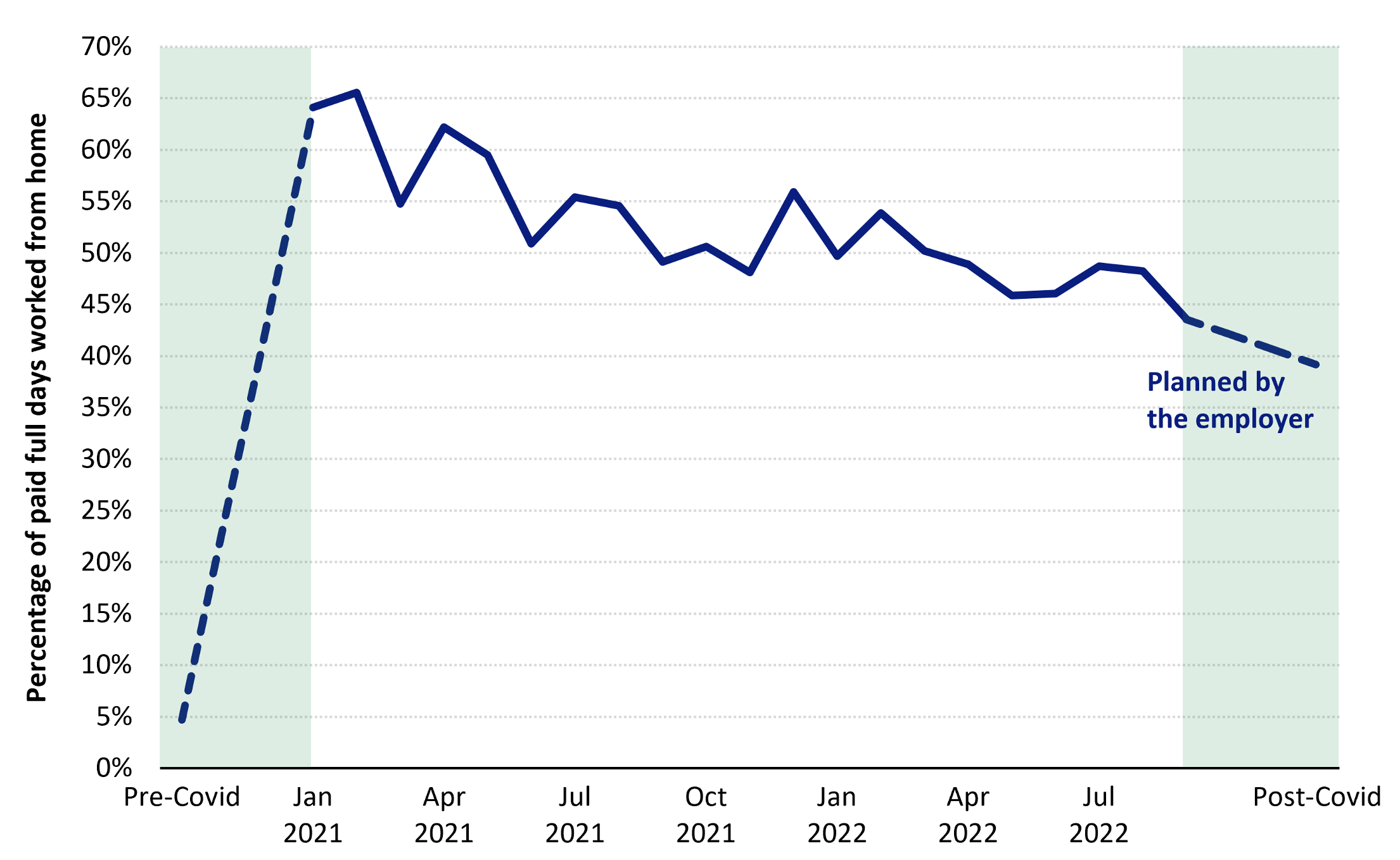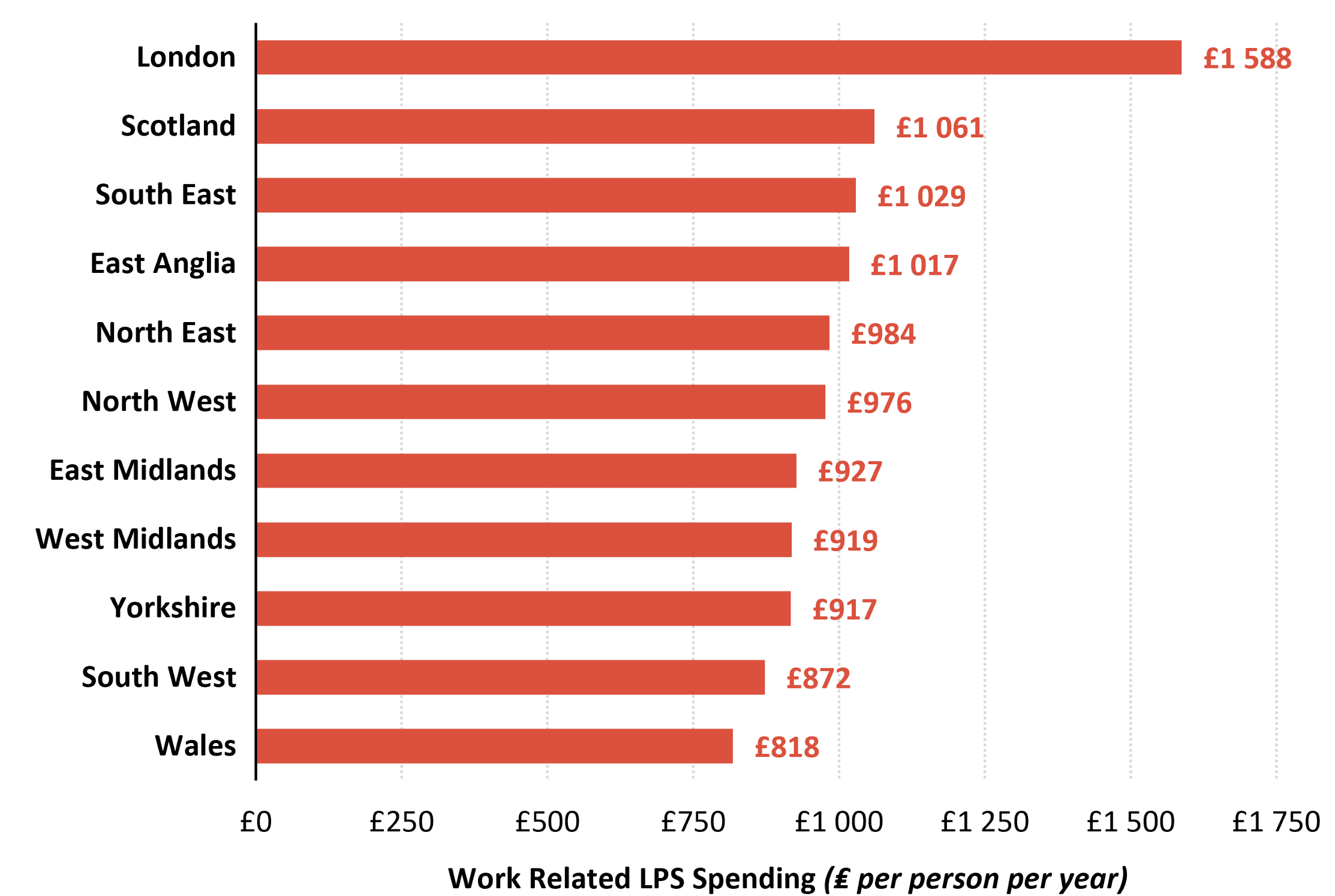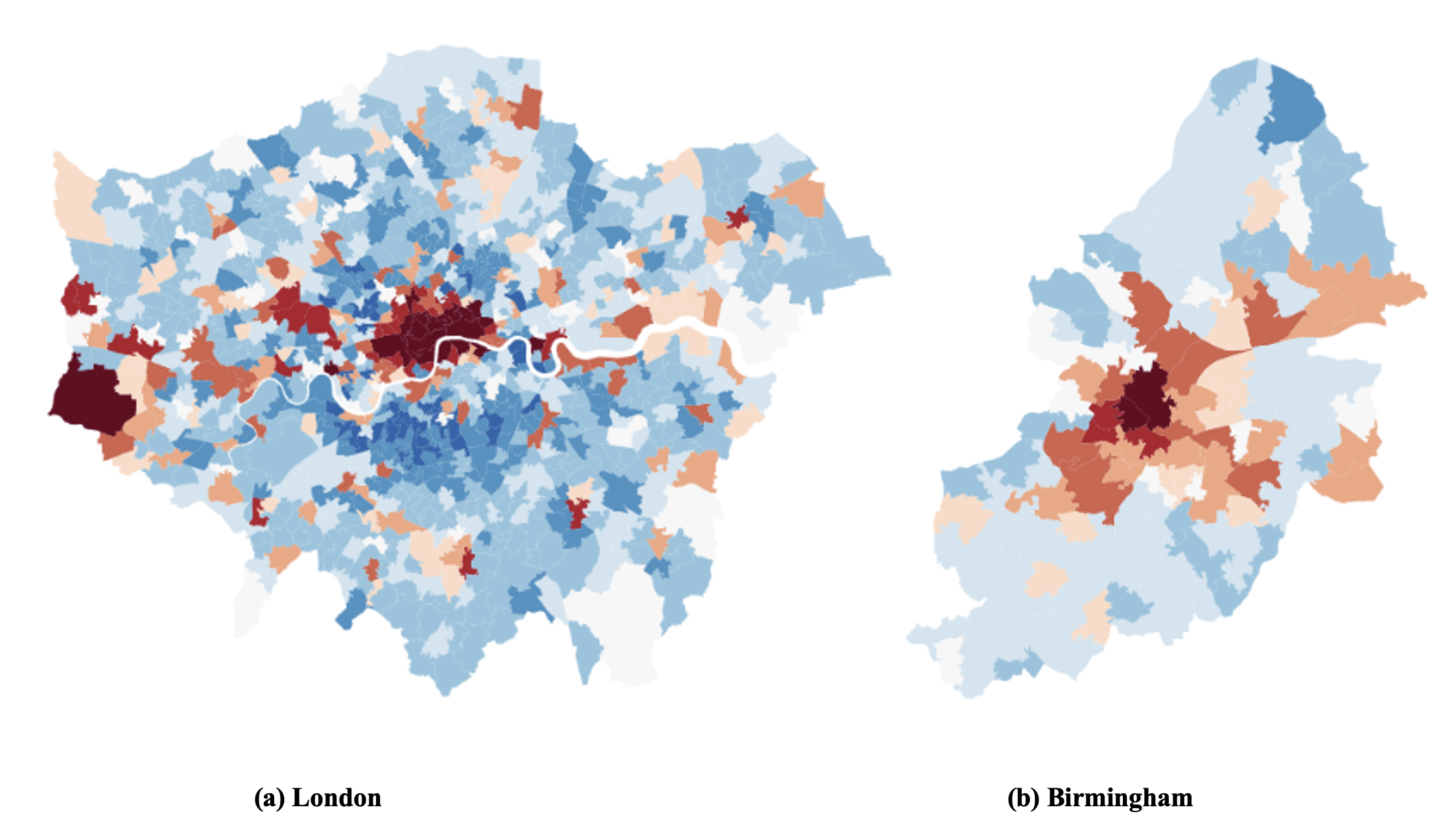The Covid-19 pandemic constituted a major disruption to labour markets, resulting in job losses, increased unemployment benefits, and a reallocation of workers across the economy (Barrero et al. 2020). Among these many changes, the shift to remote working, with its immediate implication of employees spending more time in residential suburbs and less in their city-centre offices, appears to be persisting beyond the pandemic (Althoff et al. 2022, Barrero et al.2021, De Fraja et al. 2021). This, in turn, affects where workers spend money on their morning coffees, lunches, haircuts, taxi rides, after-work drinks, gym memberships, and other such local personal services (LPS). These are potentially important effects with wide repercussions on the distribution of economic activity and the use of transport infrastructures.
To quantify these effects, the extent of the shift to remote working, and its impact on LPS workers, we use information from a bespoke nationally representative survey of more than 35,000 UK workers collected since January 2021 (De Fraja et al. 2021). This survey contains information that allows us to quantify workers’ expectations of how much they will work remotely in the near future. In our new work (De Fraja et al. 2022), we combine this with information on their pre-pandemic spending on retail and hospitality while at work and on their occupation and geographic location to calculate detailed changes in occupation and location-specific spending across England and Wales, using the methodology described in De Fraja et al. (2021).
Remote working and spending
Figure 1 plots the per cent of full days worked remotely by UK workers since December 2020. Prior to the pandemic, less than 5% of all work was done remotely. While RW has fallen since its peak of 65% in January 2021, it remains above 45%.
The trajectory in Figure 1 suggests that a large component of the pandemic-induced increase in remote working is likely to be permanent. To get a handle on precisely how large, we look at what survey respondents say about their own preferences and their employer’s plans for remote working. Overall, their answers indicate that the permanent level of remote working will be 20 percentage points higher than before the pandemic. This corresponds to one full day per week – a substantial change in attitudes towards remote working (Taneja et al. 2021). It is consistent with other evidence that working adults prefer remote working (Bloom et al. 2021) and that they increasingly use their kitchens, garages and spare rooms after this ceased to be necessary to continue working and to maintain social distancing rules (Davis et al. 2021).
The permanent increase in remote working will vary considerably by occupation and by location. There will be no increase for workers employed in food preparation and service. In contrast, those employed in computer and mathematics will experience an increase of up to two days per week over 2019 levels. Occupations which had relatively high levels of remote working before the pandemic are largely driving the changes after the pandemic. Location matters too: a lawyer in central London will see an increase in her remote working half a day per week greater than her colleague based in a smaller town.
Figure 1 Share of full working days
Notes: Data used to draw the figure are from a survey of UK residents, that Prolific carried out in January 2021 - September 2022 on behalf of the University of Nottingham and Stanford University. This sample is reweighted to match the Labour Force Survey by age, gender, and education. Pre-Covid estimates are taken from the Understanding Society dataset, the WFH report.
LPS spending while at work or near the workplace is an important component of consumer demand. Figure 2 shows the average worker’s annual spending on LPS per UK region. There is substantial variation: workers in London spend almost double the amount of those in Wales. This reflects their higher incomes, their different occupations, the higher LPS prices they face and the longer times they need to reach their workplace.
Figure 2 Spending near the workplace across UK regions
Notes: See notes for Figure 1.
Evidence of a geographic pattern to changes in spending
The stylised fact that commuters work in offices disproportionately concentrated in city centres gives rise to the ‘doughnut effect’ observed in US cities (Ramani and Bloom 2021). We find the doughnut effect to be a UK phenomenon, too, with workers in major urban areas spending less time in the central business district and more time in residential suburbs. This will have consequences for where spending on local services takes place.
Three factors must be estimated to determine how remote working impacts LPS business in a specific neighbourhood: (1) The change in the proportion of work done remotely; (2) The spending by the workers who switch to remote working; (3) The reliance of the LPS businesses on workers, relative to other consumers, such as shoppers and tourists. There are large geographical differences in the last: commuters make up about 90% of LPS spending for the City of London but less than 40% for Westminster. Other things equal, a given percentage point increase in remote working has, therefore, a considerably greater effect on LPS spending overall in the City of London than in Westminster.
These factors give rise to a particular geographic pattern in the impact of remote work on LPS spending, which has consequences for the demand for LPS workers. Our analysis suggests that a small number of city centre neighbourhoods will experience a large decline in LPS spending and employment. This will be met with a small increase in demand for LPS employment across a much larger number of suburban neighbourhoods around the periphery of cities. The concentrated nature of these changes is illustrated in Figure 3, which shows the estimated changes in employment for LPS neighbourhoods across the urban areas in London and Birmingham. As an extreme example, one central London neighbourhood, with a population of 9,721, is expected to lose 8,000 LPS jobs. This loss is equivalent to the total corresponding increase in LPS jobs across the 161 largest-gaining neighbourhoods, whose combined population exceeds 1.55 million.
Figure 3 The change in the neighbourhood's local service employment due to the permanent change in remote working
Notes: The maps, from De Fraja et al. (2022), reflect the change in the number of LPS jobs by middle super output area. Blue areas show an increase in LPS spending, while red areas represent a decrease; deeper shades indicate a higher value in absolute terms. For the sources of the data, see the notes in Figure 1.
Conclusion
It is always hard to predict the future, and particularly the future of cities, but a consensus is coalescing that cities will be different from their pre-pandemic look (Althoff et al. 2022, Rosenthal et al. 2022). If (possibly part-time) remote working does become the new normal for business interactions, there will be fundamental spillovers across industries and localities – some good, some bad. Policymaking will require a solid understanding of these externalities. Our work highlights a key one: the impact on the LPS industry and its workers in different urban environments. These workers are often amongst the lowest paid and the affluent suburbs, the areas where increases in demand for their skills are highest, are often places where suitable venues for new LPS businesses are scarce. Creating new LPS jobs in these suburban areas to replace those lost in city centres will therefore be challenging and require new and imaginative policy solutions.
References
Althoff, L, F Eckert, S Ganapati, and C Walsh (2022), “The geography of remote work”, Regional Science and Urban Economics 93: 103770.
Barrero, J M, N Bloom and S J Davis (2020), “Covid-19 and labour reallocation: Evidence from the US”, VoxEU.org, 14 July.
Barrero, J M, N Bloom and S J Davis (2021), “Why working from home will stick,” Centre for Economic Performance discussion paper No.1790.
Bloom, N, P D Mizen and S Taneja (2021), “Returning to the office will be hard”, VoxEU.org, 15 June.
Davis, M A, A C Ghent and J M Gregory (2021), “The work-from-home technology boon”, VoxEU.org, 18 April.
De Fraja, G, J Matheson and J Rockey (2021), “Zoomshock: The geography and local labour market consequences of working from home”, Covid Economics 64: 1–41.
De Fraja G, J Matheson, P Mizen, J Rockey and S Taneja (2022), “Remote working and the new geography of local service spending,” CEPR discussion Paper DP17431.
Ramani, A and N Bloom (2021), “The Donut Effect of Covid-19 on Cities”, NBER working paper 28876.
Rosenthal, S, W C Strange and J A Urrego (2022), “Are city centers losing their appeal? Commercial real estate, urban spatial structure, and COVID-19”, Journal of Urban Economics Insights 127: 103381.
Taneja, S, P Mizen and N Bloom (2021), “Working from home is revolutionising the UK labour market”, VoxEU.org, 15 April.











